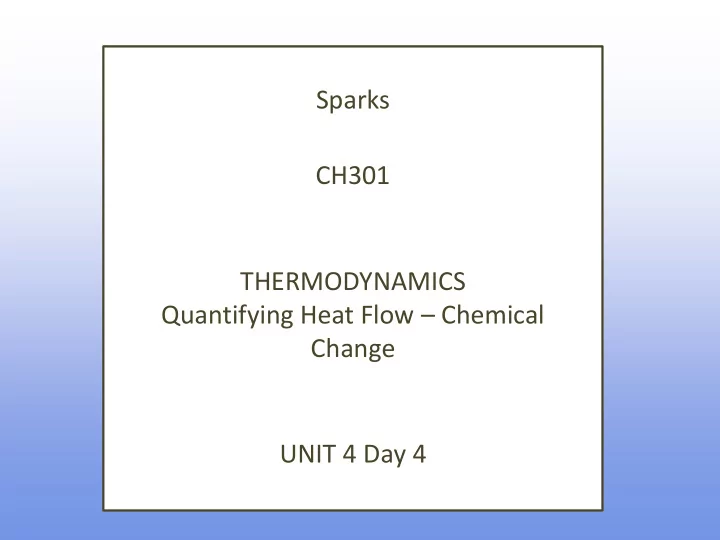

Sparks CH301 THERMODYNAMICS Quantifying Heat Flow – Chemical Change UNIT 4 Day 4
What are we going to learn today? Use calorimetry to calculate ΔH rxn Use different methods to calculate ΔH rxn Define Heats of Formation, Hess’s Law, and Bond Energies
QUIZ: iClicker Question A bomb calorimeter measures heat at constant volume, which is equivalent to a) ΔU b) ΔH c) Work
Calorimetry Example • To perform the following reaction, we add 0.10 mole of ICl to a bomb calorimeter whose heat capacity is 1.14 kJ/ o C. The temperature of 5000 g of water rose from 25.00 o C to 25.081 o C. Determine ∆E for the reaction in kJ/mol. ICl(g) ½ I 2 (s) + ½ Cl 2 (g)
D H and D E Example • An exothermic reaction was carried out in a constant pressure calorimeter. 75 kJ of heat was given off and the expanding gases pushed back on the surrounding atmosphere doing 10kJ of work. What are D H and D E?
Calculating both ∆H and ∆E, a simple review • At 25ºC and 1.0 atm, 2 mol sulfur dixoide reacts with oxygen to give sulfur trioxide: 2 SO 2 (g) + O 2 (g) 2 SO 3 (g) The reaction releases 200 kJ as heat. Calculate ∆H and ∆E for this process.
Example: Getting Thermochemical Equation (Reaction Enthalpy) from Bomb Calorimetry Data • 1.56 g of benzene, C 6 H 6 , was burned in a constant volume (bomb) calorimeter, liberating 65.25 kJ of heat. A. Write the standard chemical equation for this reaction for 1 mole of the fuel. B. Calculate Δ E in kJ/mol. C. Calculate Δ H combustion for benzene in kJ/mol.
Compare these two problems The one we just worked: This one: 1.56 g of benzene, C 6 H 6 , Using a bomb calorimeter was burned in a constant of heat capacity 155 J/ o C, containing 1000 ml volume (bomb) calorimeter, liberating of water, 1.56 g of 65.25 kJ of heat. benzene was burned. The temperature of the C. Calculate Δ H combustion for water went from 23 o C to benzene in kJ/mol. 38 o C. Use this data to find D H combustion for benzene.
Compare these two problems The one we just worked: This one: 1.56 g of benzene, C 6 H 6 , Using a bomb calorimeter was burned in a constant of heat capacity 155 J/ o C, containing 1000 ml volume (bomb) calorimeter, liberating of water, 1.56 g of 65.25 kJ of heat. benzene was burned. The temperature of the C. Calculate Δ H combustion for water went from 23 o C to benzene in kJ/mol. 38 o C. Use this data to find D H combustion for benzene.
What we’ve learned so far: Our next topics: • Internal E and • Entropy! Enthalpy – ΔE = q + w – The relationship between ΔE and ΔH – Determining enthalpy experimentally: calorimetry – Determining ΔH from tabulated data
What have we learned today? The transfer of heat energy into or out of a system at constant pressure is a state function called Enthalpy. The change in Enthalpy can be determined experimentally using a coffee cup calorimeter at constant pressure. The change in Enthalpy can be calculated based on a variety of tabulated data: Heats of formation/Other Heats of Reaction/Bond Energies
Learning Outcomes Write a formation chemical equation for a compound Calculate change in enthalpy for a reaction based on calorimetry data Calculate change in enthalpy for a reaction based on tabulated data (Hess’s law, formation data, bond energy data).
Important Information HW
Recommend
More recommend